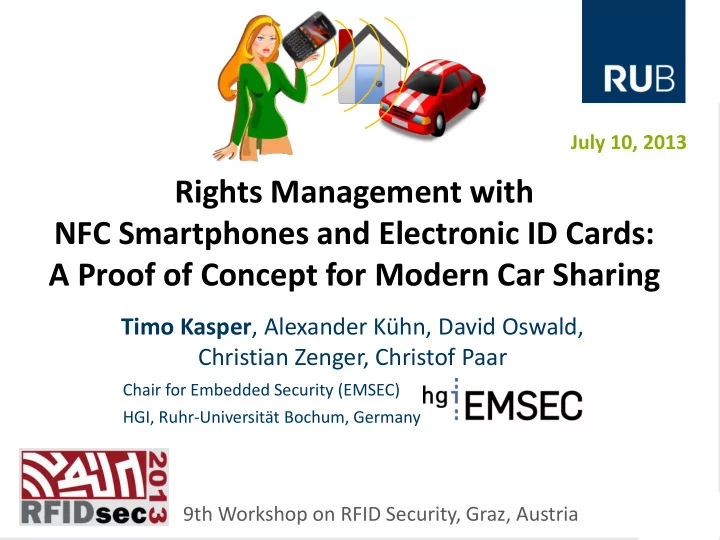

July 10, 2013 Rights Management with NFC Smartphones and Electronic ID Cards: A Proof of Concept for Modern Car Sharing Timo Kasper , Alexander Kühn, David Oswald, Christian Zenger, Christof Paar Chair for Embedded Security (EMSEC) HGI, Ruhr-Universität Bochum, Germany 9th Workshop on RFID Security, Graz, Austria
Contactless Smartcards (and NFC) defined in ISO/IEC 14443 standard large scale applications: • access control systems • electronic passports • payment systems • ticketing / public transport NFC Near Field Communication (NFC) is compatible to ISO/IEC 14443 The infrastructure (cards, readers, …) is out there Let’s use it! 2
Motivation … 3
Goals of the Project • on-line booking application • correctly identify the customer (billing , …) • transfer booked rights to phone • access booked NFC objects with phone (including scenarios without permanent Internet) • enable alternatives based on contactless cards • proof-of-concept implementation (!) 4
Ingredients 1. NFC-smartphone with Internet access (UMTS, GSM, …) here: BlackBerry Bold 9900 2. Contactless card with e-ID function here: new German electronic identity card (nPA) 3. NFC-enabled object(s) here: red car with NFC interface 5
Phase 1: Booking (NFC phone acts as RFID reader) • use e-ID card to prove customer’s identity to service provider (PACE with PIN and EAC) • credential is generated and securely transferred to the phone 6
Phase 2: Execute Booked Rights (NFC phone emulates Mifare DESfire) • car acts as NFC reader, phone emulates Mifare DESfire card • secure channel: 3DES-based mutual authentication scheme • car obtains and checks credential • if credential is valid, access is given 7
Thank you! Questions? timo.kasper@rub.de Chair for Embedded Security (Prof. Christof Paar) www.emsec.rub.de
OK, some more details ….
One-Time Registration at the Service Provider ( 𝒒𝒍 𝑻𝑸 , 𝒕𝒍 𝑻𝑸 ) ( 𝒒𝒍 𝑫 , 𝒕𝒍 𝑫 ) ( 𝒒𝒍 𝑻𝑷 , 𝒕𝒍 𝑻𝑷 ) 1. generate customer‘s public key 𝒒𝒍 𝑫 and secret key 𝒕𝒍 𝑫 2. shop stores 𝒒𝒍 𝑫 , customer ID 𝑱𝑬 𝑫 , and MRZ of nPA 3. phone stores 𝒕𝒍 𝑫 , and 𝒒𝒍 𝑻𝑸 of the service provider 10
Phase 1: Booking (NFC phone acts as RFID reader) Two steps: 1. customer identification 2. obtaining a right (credential) 11
Booking 1/2 Customer Identification secure, if special nPA reader (external pinpad) was used … 12
Booking 2/2 Obtaining a Right (Credential) • customer is identified, let‘s book s.th. ! • communication secured with TLS (assumption: TLS is secure …) • four steps: 13
Booking 2/2 Obtaining a Right (Credential) • service information 𝐽 𝑇𝑆𝑓𝑟 (e.g., GPS position of phone) • customer ID 𝐽𝐸 𝐷 • random nonce 𝑂 𝐷 • time stamp 𝑢𝑡 𝑇𝑆𝑓𝑟 14
Booking 2/2 Obtaining a Right (Credential) • service information 𝐽 𝑇𝑆𝑓𝑟 (e.g., GPS position of phone) • customer ID 𝐽𝐸 𝐷 • random nonce 𝑂 𝐷 • time stamp 𝑢𝑡 𝑇𝑆𝑓𝑟 15
Booking 2/2 Obtaining a Right (Credential) • service information 𝐽 𝐶𝑆𝑓𝑟 (e.g., GPS position of car …) • unique service object information 𝑉𝐽 𝐶𝑆𝑓𝑟 (e.g., car ID) • modified nonce 𝑂 𝐷 ‘ • time stamp 𝑢𝑡 𝐶𝑆𝑓𝑟 16
Booking 2/2 Obtaining a Right (Credential) • service information 𝐽 𝐶𝑆𝑓𝑟 (e.g., GPS position of car …) • unique service object information 𝑉𝐽 𝐶𝑆𝑓𝑟 (e.g., car ID) • modified nonce 𝑂 𝐷 ‘ • time stamp 𝑢𝑡 𝐶𝑆𝑓𝑟 17
Booking 2/2 Obtaining a Right (Credential) • service information 𝐽 𝐶𝑆𝑓𝑟 • unique service object information 𝑉𝐽 𝐶𝑆𝑓𝑟 • (more) modified nonce 𝑂 𝐷 ‘‘ • time stamp 𝑢𝑡 𝐶𝐷𝑝𝑜 18
Booking 2/2 Obtaining a Right (Credential) • service information 𝐽 𝐶𝑆𝑓𝑟 • unique service object information 𝑉𝐽 𝐶𝑆𝑓𝑟 • (more) modified nonce 𝑂 𝐷 ‘‘ • time stamp 𝑢𝑡 𝐶𝐷𝑝𝑜 19
Booking 2/2 Obtaining a Right (Credential) • Create service credential from: information 𝐽 𝑇𝐷 , (even more) modified nonce 𝑂 𝐷 ‘‘‘, unique service object information 𝑉𝐽 𝑇𝐷 , time stamp 𝑢𝑡 𝑇𝐷 , Authentication Key, and encrypted user rights credential 20
Booking 2/2 Obtaining a Right (Credential) • Create service credential from: information 𝐽 𝑇𝐷 , (even more) modified nonce 𝑂 𝐷 ‘‘‘, unique service object information 𝑉𝐽 𝑇𝐷 , time stamp 𝑢𝑡 𝑇𝐷 , Authentication Key, and encrypted User Rights Credential 21
Booking 2/2 Obtaining a Right (Credential) very easy! 22
Phase 2: Execute Booked Rights (NFC phone emulates Mifare DESfire) • Authentication Key from service credential is used to secure wireless link (DESfire mutual authentication) • Decrypt User Rights Credential with 𝒕𝒍 𝑻𝑷 and verify its signature with 𝒒𝒍 𝑻𝑸 23
Homework: Read our paper and find out how the Authentication Key is generated and updated in case of no Internet.
Secure Elements In Theory: Several options • Embedded Secure Element (eSE) • SIM card issued by communication provider • SE integrated in a (Micro) SD card In Practice: • slow (8-bit) and Java • no access granted 25
Implementation Obstacles and Security Issues Software on Smartphone: • no access to SE no secure storage • program main CPU in Java ( !! ) • RIM API doesn‘t support nPA elliptic curve (brainpoolP256r1) nPA: • No certificate for Terminal Authentication (TA) • No external pinpad / secure nPA reader Trojan in smartphone OS poses a security threat 26
Run-Time of PACE 27
Summary • Concept for secure rights management with NFC • Smartphone application for booking via TLS • NFC phone as RFID reader realizes eID function of nPA (ECDHKE in Java …) • NFC phone emulates Mifare DESfire card to open car • some remaining security issues discussed 28
Thank you! Questions? timo.kasper@rub.de Chair for Embedded Security (Prof. Christof Paar) www.emsec.rub.de www.kasper-oswald.de
Security for eMobility: Project SecMobil 30
Partners Associated Partners 31
Goals • development of a secure energy sensor • tamper-proof smart metering • standardized security architecture for electric cars • privacy and data security for end-users and suppliers 32
Introduction to Cryptography and Data Security • Lecture „ Introduction to Cryptography and Data Security“ • Videos of 2 semesters • all online: www.crypto-textbook.com 33
Recommend
More recommend